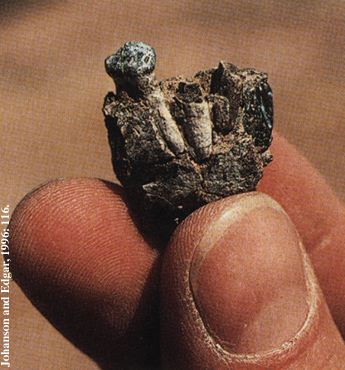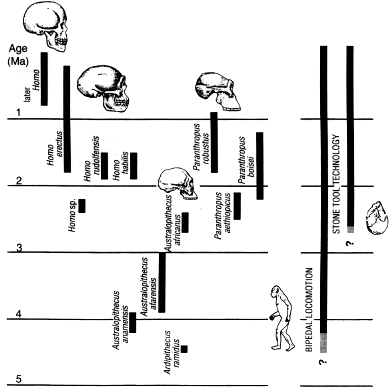Ardipithecus ramidus

Ardipithecus ramidus is the earliest
hominid found so far and was discovered in Aramis, in the
Middle Awash region of Ethiopia in 1994 by Tim White and his
two colleagues, Gen Suwa and Berhane Asfaw. Ardipithecus
ramidus translates literally as "ground man-root" and is
thought to be 4.4 to 4.5 million years old. Originally it was
named as a member of the Australopithecine family, but it was
later decided that this species differed too much from other
australopithecines and was not an ancestor.
 17 different specimens were found with many bones present.
These specimens included part of a child's mandible, some
isolated teeth, a fragment of basi-cranium, and three bones
of a left arm of a single individual. On the right an image is shown
of the upper right third molar which they found on the site. However, it cannot
be told whether this member of the hominid family was
bipedal as all hip-bones and femurs were missing. If this
was the case, then this pushes bipedal walking back even further.
The origin of bipedal walking is shown in the following figure
and as can be clearly seen, it is not sure whether bipedal walking
can be attributed to A. ramidus.
17 different specimens were found with many bones present.
These specimens included part of a child's mandible, some
isolated teeth, a fragment of basi-cranium, and three bones
of a left arm of a single individual. On the right an image is shown
of the upper right third molar which they found on the site. However, it cannot
be told whether this member of the hominid family was
bipedal as all hip-bones and femurs were missing. If this
was the case, then this pushes bipedal walking back even further.
The origin of bipedal walking is shown in the following figure
and as can be clearly seen, it is not sure whether bipedal walking
can be attributed to A. ramidus.

The dentition of Ardipithecus ramidus is more primitive
(more apelike) than that seen in
Australopithecus afarensis,
with narrower molar teeth capped with thin enamel,
unlike the condition in all other known hominines; the
canines are larger, but not as large as in living apes. The arm
exhibits both apelike and non-apelike features, from which,
White and his colleagues concluded that the mode of locomotion
cannot confidently be determined.
In an unusual move, seven months after their initial publication
in Nature, White and his colleagues published a note in
the same journal changing the genus name to Ardipithecus
(ardi means "ground floor" in the Afar language).
The authors noted that Ardipithecus was probably the
sister taxon of Australopithecus; in other words, both
species derived from an as yet unknown common ancestor. No
substantive reason was given for the change, but many observers
believe that it may be based on an early analysis of a partial
skeleton of ramidus that was discovered at the end of 1994.
Highly fragmented and encased in a matrix, the skeleton will take a
long time to prepare and analyse fully, but preliminary indications
are that it might reveal a more primitive, chimplike morphology -
hence the change of genus name. However, even though the possibility
has been raised that ramidus might even be an ape, it is
fairly sure that it is a hominid, as the very earliest hominines
were expected to be apelike (or even possibly chimplike) in many
ways such as dentition anyway. It has thus been decided that
Ardipithecus ramidus was not a direct ancestor to
later hominids.
Reference: White, TD, et al. New discoveries of
Australopithecus at Maka in Ethiopia. Nature 1994; 371: p. 306-312.
|
Ardipithecus ramidus
|
Australopithecus anamensis
|
Australopithecus afarensis
|
|
Australopithecus africanus
|
Australopithecus aethiopicus
|
Australopithecus boisei
|
|
Australopithecus robustus
|
Homo habilis
|
Homo rudolfensis
|
Homo erectus
|
Homo ergaster
|
|
Homo heidelbergensis
|
Homo neanderthalensis
|
Homo sapiens
|
 17 different specimens were found with many bones present.
These specimens included part of a child's mandible, some
isolated teeth, a fragment of basi-cranium, and three bones
of a left arm of a single individual. On the right an image is shown
of the upper right third molar which they found on the site. However, it cannot
be told whether this member of the hominid family was
bipedal as all hip-bones and femurs were missing. If this
was the case, then this pushes bipedal walking back even further.
The origin of bipedal walking is shown in the following figure
and as can be clearly seen, it is not sure whether bipedal walking
can be attributed to A. ramidus.
17 different specimens were found with many bones present.
These specimens included part of a child's mandible, some
isolated teeth, a fragment of basi-cranium, and three bones
of a left arm of a single individual. On the right an image is shown
of the upper right third molar which they found on the site. However, it cannot
be told whether this member of the hominid family was
bipedal as all hip-bones and femurs were missing. If this
was the case, then this pushes bipedal walking back even further.
The origin of bipedal walking is shown in the following figure
and as can be clearly seen, it is not sure whether bipedal walking
can be attributed to A. ramidus.
